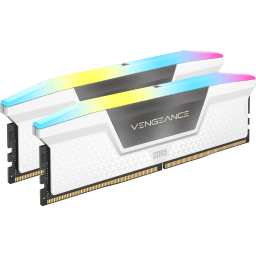Sidste år kontaktede vi Digital Foundry for at få en uafhængig test af, hvordan en opgradering fra DDR4 til DDR5 påvirker spilydelsen. Med gennemsnitlige billedhastigheder, der blev forbedret med helt op til 31 %, var resultatet klart - for at få den bedste ydeevne skal du køre DDR5.
I år vendte vi tilbage til Digital Foundry for at udføre flere uafhængige tests for at bestemme de optimale kapaciteter og frekvenser for de nyeste DDR5-platforme. Endnu en gang var CORSAIRs engagement begrænset til kun at levere den nødvendige hardware og hukommelse til testen. Vi var ikke involveret i den egentlige benchmarking, som blev udført i henhold til Digital Foundrys usædvanligt høje standarder.
Formålet med testen var at undersøge, hvordan forskellige hukommelseskonfigurationer påvirker billedhastigheden i nyere, populære titler:
- Påvirker kapaciteten, hvor glat et spil føles?
- Hvad med hukommelsesfrekvensen?
Digital Foundry satte sig for at besvare disse spørgsmål med sin fantastiske opmærksomhed på detaljer.
Testkonfiguration
Det er måske ikke fokus for denne testrunde, men vi ønskede stadig at sammenligne DDR4- og DDR5-hukommelse. Derfor er en Intel Core i9-13900KF stadig et godt valg. Intels 13. generations Core-processorer er næsten identiske med de lidt nyere 14. generations CPU'er, så vi har holdt os til den eksisterende chip og brugt den til både DDR4- og DDR5-test. Resultaterne er stort set platformsuafhængige, og du bør opleve den samme ydelse, uanset om du bruger en AMD- eller Intel-CPU.
Der blev brugt to bundkort under testen: et MSI MAG B660M MORTAR MAX til at vurdere DDR4-ydelsen og et ASRock Intel Z790 Steel Legend til DDR5. Bortset fra det og den anvendte hukommelse forblev resten af systemet det samme, inklusive grafikkortet, et Nvidia GeForce RTX 4090. Derudover blev der brugt samme lagerplads og version af Windows 11 til begge platforme.

Vi har opdateret de spil, som Digital Foundry brugte til denne testrunde, herunder nyere udgivelser og vigtige titler til pc: Baldur's Gate 3, Starfield, Star Wars Jedi: Survivor, Dragon's Dogma 2 og Microsoft Flight Simulator. Det er alle populære titler, som ser fantastiske ud på pc, især i 4K med de bedst mulige indstillinger.
Alle test blev udført ved 4K (3840 x 2160) med de højest mulige indstillinger og med raytracing aktiveret, hvor det var relevant, samt DLSS. Du kan finde en komplet oversigt over resultaterne på siden Benchmarking.
Digital Foundry optog optagelser for hver kørsel for at muliggøre sammenligninger mellem hukommelsessættene og gav detaljerede oplysninger om billedhastigheden. De gennemsnitlige billedhastigheder er mest interessante her, selvom de 1 % mindste billedhastigheder også afslører meget om, hvor glat et spil føles at spille. I begge tilfælde gælder det, at jo højere billedfrekvens, jo bedre.

Du vil have 32 GB DDR5-6000 C30 RAM til pc-gaming
PC-gaming elsker hukommelse med høj frekvens og lav latenstid. Det er nok ikke en overraskende nyhed for langvarige pc-gamere, men det kan være svært at finde ud af, præcis hvilke sæt der rammer plet - de skal finde en balance mellem ydelse og værdi for pengene. I betragtning af DDR5's modenhed lige nu anbefaler vi at vælge et 32 GB hukommelsessæt, der kører med 6000 MT/s og har en CAS-latency på 30. Sådanne sæt vil øge dine gennemsnitlige billedhastigheder med op til 14 % sammenlignet med 16 GB DDR5-4800-konfigurationer.
Vi anbefaler vores 32 GB VENGEANCE RGB DDR5-6000-sæt til dette formål og vores 32 GB VENGEANCE DDR5-6000 til dem, der ikke har brug for LED'er. Hvis du er en power-bruger, der gerne vil spille, samtidig med at du laver mere krævende ting, kan en 64 GB-version af de samme sæt være en bedre løsning. Hvis du vil have et førsteklasses touch, er 64 GB DOMINATOR TITANIUM DDR5-6000-sættet et godt valg, og det fås også i et 32 GB-sæt.
Det er værd at understrege, at vi har valgt 16 GB DDR5-4800 som basiskonfiguration for sammenligninger, da det er en hukommelseskonfiguration, der i stigende grad bruges til almindelige spilsystemer. Så det handler ikke kun om at vælge et hukommelsessæt, der kører med en højere frekvens, men også med en højere kapacitet.

For at få den bedste ydeevne lige nu og den bedste kompatibilitet med de nyeste spil, skal du have 32 GB hurtig RAM.
Dette bekræftes af andre uafhængige testere og anmeldere. Hardware Unboxed stillede spørgsmålet How Much RAM Do Gamers Need? 16GB vs. 32GB vs. 64GB og kom frem til en endelig konklusion: "Til et spilsystem er 32 GB hukommelse det bedste, og det burde være rigeligt i den nærmeste fremtid." TechSpot stillede i mellemtiden et lignende spørgsmål og konkluderede: "Svaret er 32 GB." Begge er værd at tjekke ud, hvis du er interesseret i et dybere dyk ned i, hvorfor 16 GB ikke længere er det bedste.
Hvad hvis du stadig bruger en DDR4-platform? Vi har en separat artikel, der dækker dine DDR4-opgraderingsmuligheder, men spoilers: opgradering til 32 GB er stadig din bedste mulighed for at få en mere jævn oplevelse.









